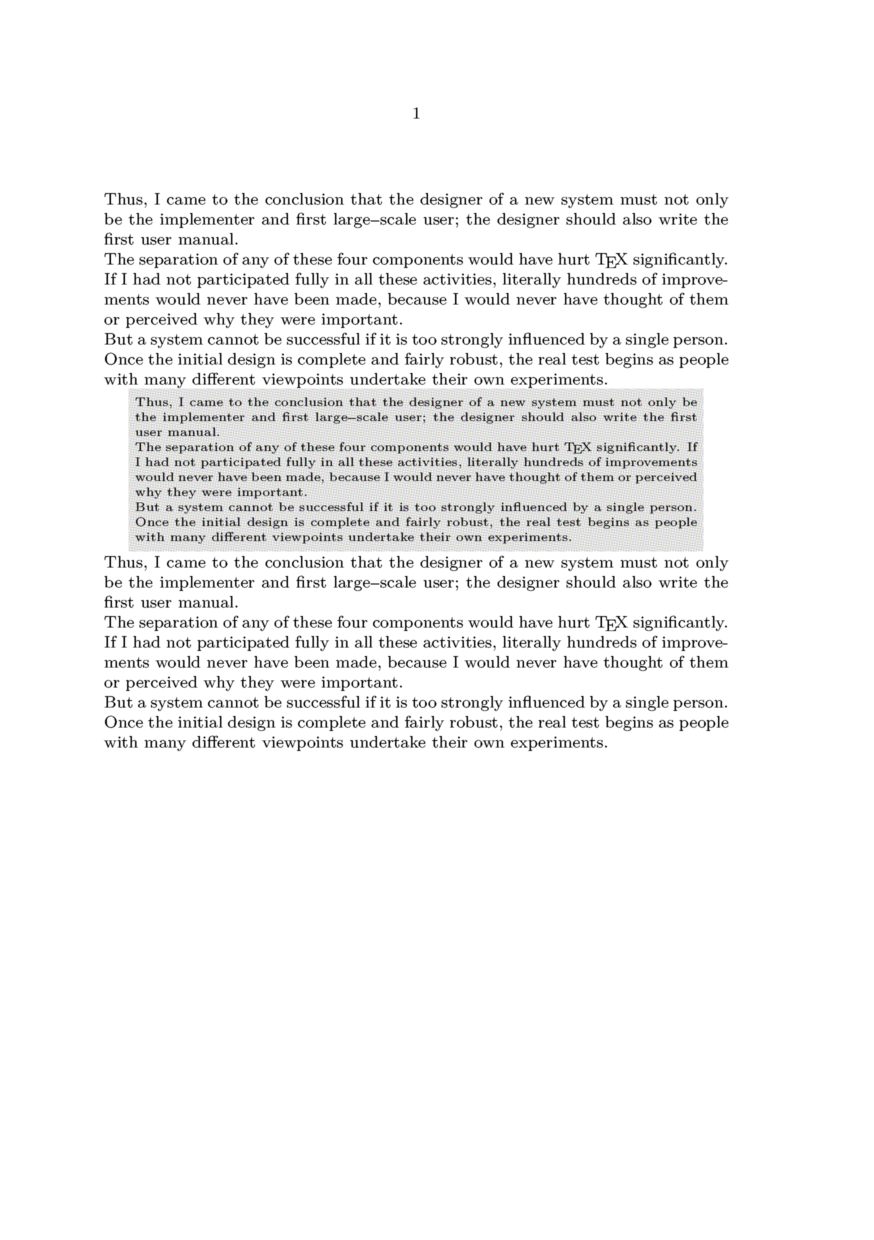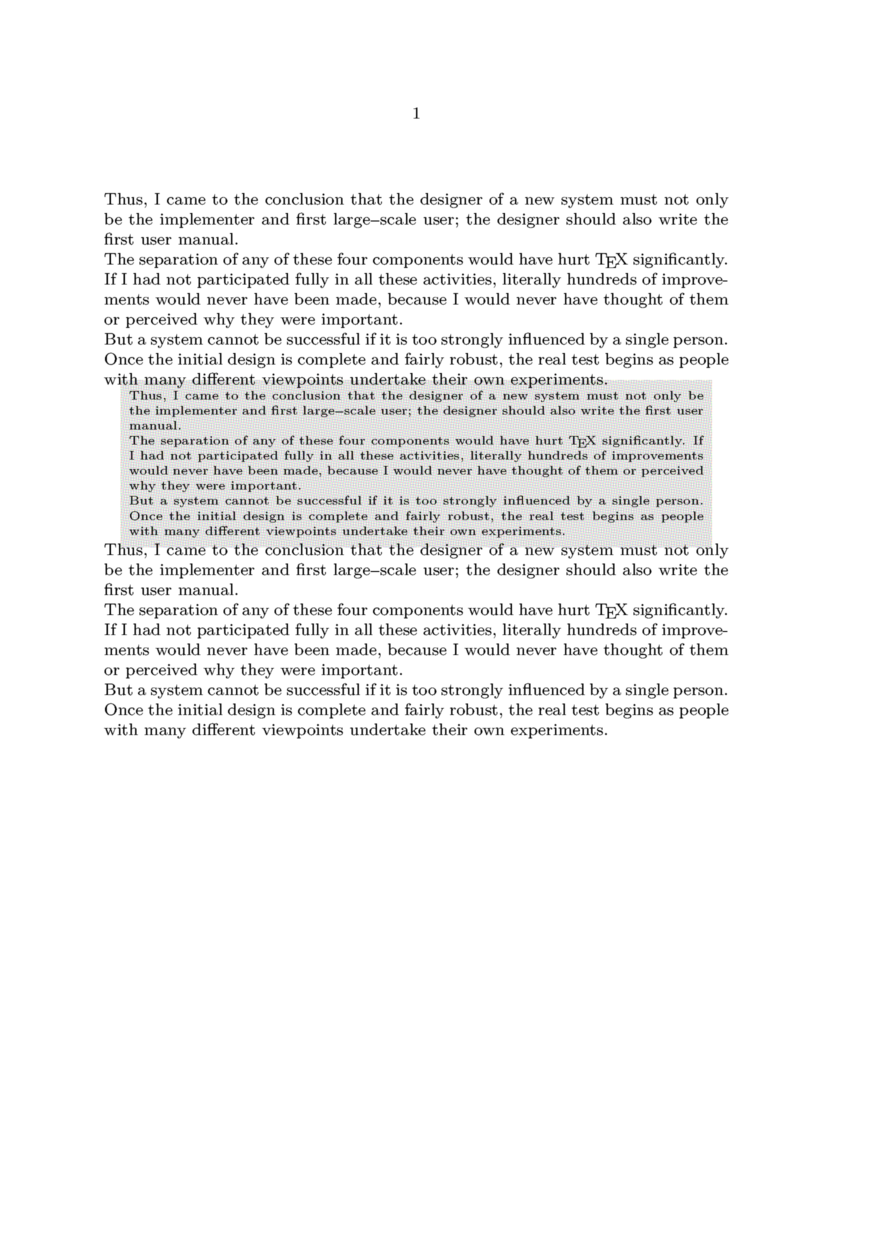Difference between revisions of "TextBackground"
m (Text replacement - "</cmd>" to "}}") |
(more intro) |
||
| (2 intermediate revisions by the same user not shown) | |||
| Line 1: | Line 1: | ||
{{todo|Add more examples of usage of textbackgrounds.}} | {{todo|Add more examples of usage of textbackgrounds.}} | ||
| − | Pages, paragraphs, words can have a background color or | + | == Basics == |
| + | |||
| + | Pages, paragraphs, words can have a background color or [[Overlays|overlay]]. ConTeXt creates these using [[MetaPost]]. | ||
| + | |||
| + | But a usual frame is only one object, its contents can’t flow over to the next page. | ||
| + | |||
| + | You can use {{cmd|definetextbackground}} to define a named text background. The environment is based on {{cmd|framed}} and understands its parameters, but can contain several paragraphs and page breaks. | ||
| + | |||
| + | After `\definetextbackground[Name]` you can use `\startName ... \stopName` (if there’s no name conflict) or `\starttextbackground[Name] ... \stoptextbackground`. Usually you won’t need {{cmd|setuptextbackground}}. | ||
| + | |||
| + | The `location` parameter changes the behaviour between `text` (highlighting running text) and `paragraph` (boxed paragraphs). | ||
(See, eventually, the [[manual:details.pdf| details]] manual or the {{src|anch-bck.mkvi|source}} for further explanations.) | (See, eventually, the [[manual:details.pdf| details]] manual or the {{src|anch-bck.mkvi|source}} for further explanations.) | ||
| + | |||
| + | |||
| + | '''Beware''': The examples using {{cmd|startnarrower}} may be misleading – of course you can use {{cmd|startbackground}} without the `narrower` environment; it behaves differently without `\starttext ... \stoptext`. | ||
== Example: multi-page backgrounded text == | == Example: multi-page backgrounded text == | ||
| Line 25: | Line 38: | ||
frame=off,] | frame=off,] | ||
| − | \ | + | \starttext |
| + | \samplefile{knuth} | ||
\startsecondary | \startsecondary | ||
| − | \ | + | \samplefile{knuth} |
\stopsecondary | \stopsecondary | ||
| − | \ | + | \samplefile{knuth} |
| + | \stoptext | ||
</context> | </context> | ||
| Line 48: | Line 63: | ||
frame=off,] | frame=off,] | ||
| − | \ | + | \starttext |
| + | \samplefile{knuth} | ||
\startsecondary | \startsecondary | ||
| − | \ | + | \samplefile{knuth} |
\stopsecondary | \stopsecondary | ||
| − | \ | + | \samplefile{knuth} |
| + | \stoptext | ||
</context> | </context> | ||
| Line 61: | Line 78: | ||
Underlining is generally frowned upon by experienced TeXnicians. Occasionally, | Underlining is generally frowned upon by experienced TeXnicians. Occasionally, | ||
however, it is necessary and {{cmd|ul}} or {{cmd|underbar}} doesn’t do what you want. In those | however, it is necessary and {{cmd|ul}} or {{cmd|underbar}} doesn’t do what you want. In those | ||
| − | cases using | + | cases using {{cmd|definetextbackground}} for the underlining may also be tried. |
<context source="yes"> | <context source="yes"> | ||
\definetextbackground[underline] | \definetextbackground[underline] | ||
[location=text,alternative=1,background=,frame=off] | [location=text,alternative=1,background=,frame=off] | ||
| + | |||
\definestartstop[underline] | \definestartstop[underline] | ||
[before={\starttextbackground[underline]}, | [before={\starttextbackground[underline]}, | ||
after=\stoptextbackground] | after=\stoptextbackground] | ||
| + | \startTEXpage | ||
An example with \startunderline underlined\stopunderline\ text. | An example with \startunderline underlined\stopunderline\ text. | ||
| + | \stopTEXpage | ||
</context> | </context> | ||
| Line 82: | Line 102: | ||
setbounds currentpicture to p ; | setbounds currentpicture to p ; | ||
\stopuseMPgraphic | \stopuseMPgraphic | ||
| + | |||
\definetextbackground[underline] | \definetextbackground[underline] | ||
[location=text,alternative=1,background=,frame=off] | [location=text,alternative=1,background=,frame=off] | ||
| + | |||
\definestartstop[underline] | \definestartstop[underline] | ||
[before={\starttextbackground[underline]}, | [before={\starttextbackground[underline]}, | ||
after=\stoptextbackground] | after=\stoptextbackground] | ||
| + | |||
| + | \startTEXpage | ||
An example with \startunderline underlined\stopunderline\ text. | An example with \startunderline underlined\stopunderline\ text. | ||
| + | \stopTEXpage | ||
</context> | </context> | ||
| Line 106: | Line 131: | ||
\startdashed | \startdashed | ||
| − | \ | + | \samplefile{ward} |
\stopdashed | \stopdashed | ||
</context> | </context> | ||
| − | |||
| − | |||
| − | |||
| − | |||
[[Category:Basics]] | [[Category:Basics]] | ||
Latest revision as of 19:03, 6 December 2023
 |
TODO: Add more examples of usage of textbackgrounds. (See: To-Do List) |
Contents
Basics
Pages, paragraphs, words can have a background color or overlay. ConTeXt creates these using MetaPost.
But a usual frame is only one object, its contents can’t flow over to the next page.
You can use \definetextbackground to define a named text background. The environment is based on \framed and understands its parameters, but can contain several paragraphs and page breaks.
After \definetextbackground[Name] you can use \startName ... \stopName (if there’s no name conflict) or \starttextbackground[Name] ... \stoptextbackground. Usually you won’t need \setuptextbackground.
The location parameter changes the behaviour between text (highlighting running text) and paragraph (boxed paragraphs).
(See, eventually, the details manual or the source for further explanations.)
Beware: The examples using \startnarrower may be misleading – of course you can use \startbackground without the narrower environment; it behaves differently without \starttext ... \stoptext.
Example: multi-page backgrounded text
Perhaps one might like to offset examples from the running text, or signal to the reader that the following paragraphs contain secondary, detailed information that is of interest only to the specialists. This can be achieved using textbackground.
In contrast, Framed creates text blocks that do not span columns or pages.
In the following example, we also reduce the textwidth and bodyfont size.
\definetextbackground[secondary][ location=paragraph, background=color, backgroundcolor=lightgray, leftoffset=.5\bodyfontsize, rightoffset=.5\bodyfontsize, topoffset=.5\bodyfontsize, bottomoffset=.5\bodyfontsize, before={\startnarrower\switchtobodyfont[small]}, after={\stopnarrower}, frame=off,] \starttext \samplefile{knuth} \startsecondary \samplefile{knuth} \stopsecondary \samplefile{knuth} \stoptext

Background Offset
The options left, right, top, bottomoffset can be replaced by backgroundoffset yielding a different result:
\definetextbackground[secondary][ location=paragraph, background=color, backgroundcolor=lightgray, backgroundoffset=.5\bodyfontsize, before={\startnarrower\switchtobodyfont[small]}, after={\stopnarrower}, frame=off,] \starttext \samplefile{knuth} \startsecondary \samplefile{knuth} \stopsecondary \samplefile{knuth} \stoptext

Underlining with Text Backgrounds
Underlining is generally frowned upon by experienced TeXnicians. Occasionally, however, it is necessary and \ul or \underbar doesn’t do what you want. In those cases using \definetextbackground for the underlining may also be tried.
\definetextbackground[underline] [location=text,alternative=1,background=,frame=off] \definestartstop[underline] [before={\starttextbackground[underline]}, after=\stoptextbackground] \startTEXpage An example with \startunderline underlined\stopunderline\ text. \stopTEXpage

If desired, the location of the line can also be adjusted.
\startuseMPgraphic{mpos:par:columnset} % Shift underlining down a touch \iftracepositions show_multi_pars \else draw_multi_pars \fi ; path p ; p := boundingbox currentpicture ; currentpicture := currentpicture shifted (0,-StrutDepth/3) ; setbounds currentpicture to p ; \stopuseMPgraphic \definetextbackground[underline] [location=text,alternative=1,background=,frame=off] \definestartstop[underline] [before={\starttextbackground[underline]}, after=\stoptextbackground] \startTEXpage An example with \startunderline underlined\stopunderline\ text. \stopTEXpage

Example: dashed underbar
(by WS, 4/2011)
\definetextbackground [dashed] [location=text, framecolor=black, alternative=1, voffset=-\strutdp, background=, frame=off, dash=1] \startdashed \samplefile{ward} \stopdashed
